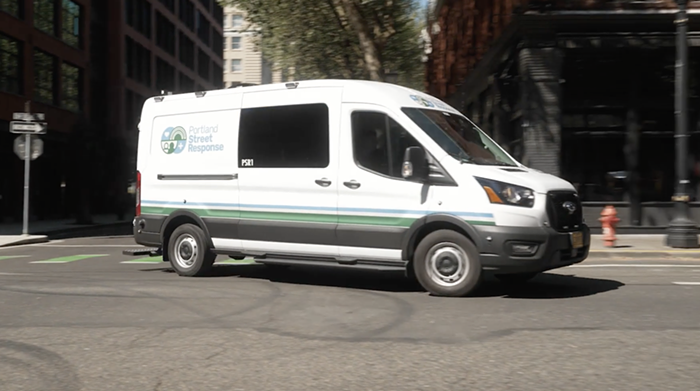"HERE THEY COME!"
The call goes up before the bicycles roll to a complete stop on a recent Friday, sending a ripple of energy up and down the Central Eastside block.
Soon, grateful drug users are coming from every direction to speak with four volunteers bearing stuffed backpacks and two bountiful bike trailers.
"Needles?" asks one woman. "Who brought needles?" She's handed a pack of 50 new syringes, and offered her choice of an array of injection materials—three sizes of cotton wads, two kinds of rubber tourniquets (in case anyone's allergic to latex), tiny cups for cooking heroin, kits for treating wounds caused by injections, and more.
"Can I have a sharps container, gentlemen?" asks another woman. She walks away with a dark red canister for her dirty needles—along with 50 clean ones.
A girl in a hoodie, running shorts, and sneakers comes down the block, looking as though she could have just finished a jog. After grabbing a pack of syringes, she hustles off again.
This same scene has played out around Inner Portland every week for the last year and a half—ever since the Portland People's Outreach Project (PPOP) began delivering injection supplies to drug users by bike.
The small, volunteer-run group began in February 2015, an offshoot of a similar Seattle-based organization. It's one of a handful of operations that offers clean needles and other equipment to users in Portland. It's also the most radical.
PPOP gives out meth pipes, along with syringes. And the group is alone in that it doesn't require its clientele to exchange dirty needles for clean, the thinking being that lack of access to clean needles inspires people to use filthy, dangerous ones. Anyone can get 50 needles from the roving bike crew, regardless of whether they hand in dirties. PPOP gives out around 5,000 new needles a week on its rounds, and collects a fraction of that number in used syringes.

"The evidence is, despite the consequences, people are going to use," says Sam Junge, PPOP's harm reduction coordinator and one of the four people handing out supplies. "I see it every day."
Some of the people Junge and his fellow volunteers are serving on this Friday have been the recent subject of outsized notoriety. They're Portlanders with addictions and no home in which to feed them—the much-bemoaned public drug users deemed villains in the city's ongoing struggle with homelessness.
Portland is not alone in that struggle. And just like other cities around the country, we've just begun to discuss one possible option for easing it: supervised injection facilities (SIFs).
Accepted in Europe and Australia, but nearly nonexistent in North America, these are places where drug users can safely inject drugs—or, in some cases, smoke them—under the watch of medical professionals and with access to sterile supplies.
Like widely accepted needle exchanges, SIFs are part of a "harm reduction" model that accepts that people are using drugs, and seeks to limit overdoses, disease transmission, and other health concerns from unsafe use. That can save money, because communities are addressing fewer health problems and deaths. It also means people are no longer forced to inject under bridges and between parked cars.
At the one SIF that exists in North America—Vancouver, BC's 13-year-old Insite facility—research suggests benefits for the immediate neighborhood. Those include fewer overdoses, fewer discarded needles, and fewer thefts and car break-ins. Researchers say there's no evidence that the site has created new drug users.
Crucially, studies also suggest Insite has smoothed the path between users and drug treatment. Similar sites around the world have yielded the same result.
"If the evidence were lousy, I'd say, 'How can I endorse this?'" says Dr. Rachel Solotaroff, medical director at Central City Concern. "In the setting of compelling evidence, I find it really hard to say this would be unhelpful."
Right now, Portland is nowhere close to establishing a SIF—but that might be changing.
Earlier this month, two New York social workers and filmmakers, Matt Curtis and Taeko Frost, came to Portland to screen Everywhere But Safe, their film about the perils of public injection in New York state. The event was organized by street newspaper Street Roots, which has been calling on Portland leaders to create a SIF since last August.
At the same time, the paper convened a forum with local officials—representing police, health care, and social services—to introduce the concept of SIFs and discuss their potential benefits.
The same strategy had dramatic results in Seattle.
Since a forum on SIFs last November, Seattle has launched a Heroin and Prescription Opiate Addiction Task Force. That task force is due to release an array of recommendations in September, and people involved are confident one of them will be that officials should seriously consider a city- and county-sanctioned supervised consumption space, where drug users would be able to smoke as well as inject.
That means our northern neighbors might be on the verge of a national first.
"Most other cities have hit some sort of roadblock," says Patricia Sully, who sits on the Seattle task force and advocates for safe facilities with the group Voices of Community Activists and Leaders—Washington (VOCAL-WA). "They've had some important stakeholder say, 'Absolutely not, we are not doing this.' Seattle has yet to have that."
Portland has plenty of reasons to take note.
In the last 15 years, the rate of fatal heroin overdose has shot dramatically up in Multnomah, Clackamas, and Washington Counties. From 2000 to 2002, an average of 1.154 people in every 100,000 died from heroin overdose in the tri-county region, according to the Oregon Health Authority. From 2012 to 2014, that average was 4.132 people in every 100,000. Statewide, fatal heroin overdoses increased over the same timeframe. Oregon saw 28 fatal heroin overdoses in 2000, and 115 in 2012.
Advocates and experts point to a central reason for the spike, which is also being felt elsewhere around the country: Harsh restrictions on highly addictive prescription opioids like oxycodone have sent more and more people scrambling to heroin's similar fix.
"There is an issue of public drug use," says Israel Bayer, executive director of Street Roots. "People are shooting up in social service bathrooms and businesses downtown. We as a community have chosen to put our heads in the sand and acknowledge it's there, but not come up with any clear strategy to address it."
Outside In, which has operated a needle exchange in Portland for the last 27 years, expects it will distribute more than 1 million syringes next year for the first time in its history, says Executive Director Kathy Oliver. A decade ago, it was giving out roughly half that.
Combined, the county health department and Outside In exchanged nearly 3.1 million needles in 2015, a 59 percent increase over 2012.
"I think it's the increase of people here in Portland," says Oliver. "And the increase in heroin use nationwide."
Oliver is clear that her organization hasn't taken a position on SIFs—it won't until there's a credible proposal, if that ever happens. But she sees the benefits.
"The more contact between drug injectors and public health people, the better," Oliver says. "When [drug users] are ready or want to make changes, we want to be there for them."
But public health officials and other social services agencies aren't ready to commit. Officials at the Multnomah County Health Department met with SIF advocates on their recent tour through town, says health department spokesperson Julie Sullivan-Springhetti.
"The county is looking at this, thinking about this, talking about this," Sullivan-Springhetti says, noting, "There is no position at this point."
Mayor Charlie Hales is hoping to set up a new "navigation center" in Portland—a homeless shelter model borrowed from San Francisco, which includes tacit permission for addicts to use drugs offsite. In Seattle, advocates have argued a similar space should include a SIF to prevent open drug use in the surrounding neighborhood. Hales' office won't address whether that's a possibility here.
"Navigation center discussions have not reached the point of deciding what services would be provided," spokesperson Sara Hottman says.
Portland Police Commander Sara Westbrook, who attended the recent meeting, didn't respond to repeated requests to talk. Central City Concern is still "in listening mode," a spokesperson said.
Street Roots' Bayer says he'll continue to push the issue, even without committed interest from officials.
"I get the sense that they're treating us like cute puppy dogs," he says. "Having an elected official go out on a limb and use their political capital is a big lift, but it doesn't change the fact that we have people experiencing homelessness who are both overdosing and dying on our streets."
For Junge and the other PPOP volunteers making their weekly bike circuit, that's the central issue.
"Telling people they're loved and cared for," Junge says, incredulous, as the group prepares to ride to its second stop of the night, "it's telling them that that's considered radical."



















